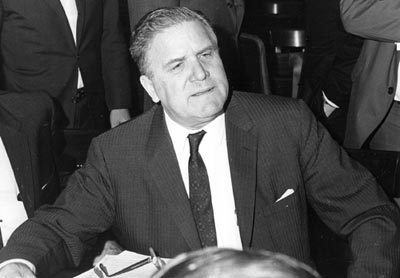Webb’s Giantby Dwayne A. Day
|
| Webb’s Giant was the NASA administrator’s ultimate insurance policy, the kind of ace in the hole that has not existed since then, and whose absence will continue to haunt future NASA leaders. |
What they reveal is that Webb’s public pronouncements about the Soviet response to Apollo closely tracked with what the intelligence community—primarily the CIA—was telling him. Webb was regularly briefed on Soviet progress and apparently allowed by the CIA to speak publicly about what he knew. As the intelligence information changed, and improved, Webb’s public statements changed as well. That story can now be told.
A giant leap of faith
When John F. Kennedy approved the Apollo program in May 1961 he did so essentially blind. He did not know if the Soviet Union had its own lunar program. The Soviets did not talk about landing humans on the Moon, and American intelligence assets on the Soviet space program were extremely limited. Usually the CIA knew about a Soviet space project only after it was orbiting overhead, and that was happening all to frequently. As Sayre Stevens, a Soviet space analyst in the CIA’s Office of Scientific Intelligence put it, “What was clear was that they were beating the shit out of us.”
When Jim Webb became NASA administrator in early 1961 he was granted top security clearances—not only access to intelligence data, including satellite photographs, but access to the technical information about the spy satellites themselves. The relationship between the CIA and NASA had become strained under Webb’s predecessor, T. Keith Glennan, who felt that NASA’s reputation had been hurt during the incident involving the shoot-down of Gary Powers’ U-2 spyplane in May 1960. Webb assured the CIA leadership that he wanted to work with them, and in return they granted him access to all the best information.
However, in the years immediately after Kennedy established the lunar goal there was almost no information at all indicating that the Soviets had a lunar program. In summer 1963 a Soviet scientist told a British scientist that the Soviets did not have plans for landing humans on the moon. This information was at the time accurate, but it rippled through American government circles. Why was the United States spending billions to race the Soviets to the moon if the Soviets were not planning on going there themselves?
Starting in spring 1963 American spy satellites photographed a massive construction project at Tyura-Tam, the Soviet launch range. They soon designated this “Launch Complex J”—the tenth launch facility detected at Tyura-Tam—and speculated that it was intended for launching a massive new space rocket.
| One big problem was that the analysts who focused on Complex J could not understand why, if the Soviets were racing the Americans to the Moon, it took them so long to finish the launch facility. |
For the first six months or so, through the fall of 1963, the construction was only worker housing. Then the construction workers, many of them Soviet army troops, began building concrete batch plants, technical facilities, and apartments, and soon what the CIA designated the “missile assembly building,” or MAB, where they would construct the rocket. By 1964 they started digging pits for two launch pads and American intelligence analysts began speculating about the size of the rocket that would be launched from there, at first erroneously thinking that the rocket might be assembled vertically inside, or next to the long building.
But the analysts who looked at the photographs also could not determine if the rocket facility was for a lunar program. One big problem was that the analysts who focused on Complex J could not understand why, if the Soviets were racing the Americans to the Moon, it took them so long to finish the launch facility. They had clearly started behind the United States and they needed to catch up. But there were long pauses in the construction. “We looked at this and nothing happened!” Stevens exclaimed, still exasperated over forty years later. “It took them forever… It just didn’t seem like it was the way they would be doing it if they were really gonna chase us down.”
